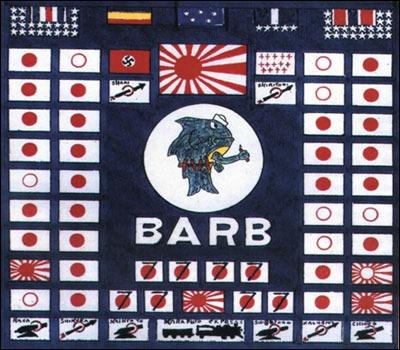Of course, few remember the U.S. invasion of Japan on July 22, 1945, by a submarine. Take a look at the final battle flag of the U.S.Barb.
That bottom line showed the results of their twelfth patrol, led by Captain Eugene Fluckey. She was the first submarine to execute a ballistic missile attack, one of Fluckey's innovations. But the center icon in that lower row is what concerns us. This from the Navy History and Heritage Command:On 19 July 1945, Fluckey observed a train travelling on tracks along the Sakhalin coast and hatched one of the most daring operations in the annals of U.S. submarine warfare. For three nights, Fluckey observed the trains in order to determine the schedule. On the night of 22–23 July, a landing party of eight volunteers went ashore to plant explosives on the train tracks. The landing party had difficulty making its way across the terrain, and had to hide in the bushes as the first train passed only a few feet away before the 55-pound charge could be set. As the landing party was paddling back to Barb, the next train came by, detonating the explosives. Pieces of the locomotive flew 200 feet into the air, and 12 freight cars, 2 passenger cars, and a mail car derailed and piled into a twisted mass. JapaneseMore HERE.propaganda claimed that civilian passengers were killed, but intelligence indicated that trains traveling at night carried troops. This is claimed as the only ground combat on the Japanese Home Islands during World War II, and though Sakhalin is not now a Japanese island, in 1945, technically it was a “Home Island.”
BobInformation

Warning: This is a relatively older thread
This discussion is older than 360 days. Some information contained in it may no longer be current.
- Knowledge Library

- MKL Entry of the Month
- Australia
- Austro-Hungarian Empire
- Canada
- Czechoslovakia
- Denmark
- Finland
- France/Belgium
- Germany
- Italy
- Japan
- Norway
- Russia
- South America
- Sweden
- Switzerland
- Turkey
- United Kingdom
- United States
- Yugoslavia
- Is my rifle authentic or a fake?
- Jay Currah's Lee Enfield Web Site
- On-line Service Records (Canada)
- Technical Articles/Research
- Forum
- Classifieds

- What's New?
-
Photo Gallery

- Photo Gallery Options
- Photo Gallery Home
- Search Photo Gallery List
-
Photo Gallery Search
- Video Club

- iTrader












 PM
PM

